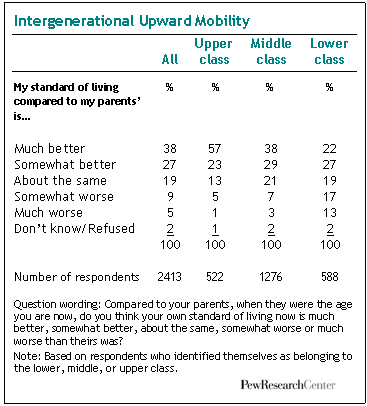
Even before the current recession settled in, the American middle class felt stuck in its tracks. The Pew Research survey was conducted in January and February of 2008, during the early days of what was then a still-not-yet officially declared recession. Even so, a majority of self-identified middle class survey respondents said then that in the past five years, they either hadn’t moved forward in life or had actually fallen backward. Though there are some differences by income class, the total U.S. population, in the aggregate, felt essentially the same way: some 25% said they hadn’t moved forward in life, and 31% said they had fallen backward. This was the most downbeat short-term assessment of personal progress in nearly half a century of polling by the Pew Research Center and the Gallup organization.
However, the public’s judgments about its economic mobility aren’t all negative. When we asked respondents to measure their progress over a longer time frame, their glasses became more than half full. Two-thirds of all respondents said they had a higher standard of living than their parents had when their parents were their age. Just 14% said their standard of living was lower.
In both of these sets of judgments — short term stagnation, long term progress — those who self-identify as middle class fall out where one would expect on the socio-economic ladder. They are more upbeat about their progress than are those who self-identify with the lower class, but less upbeat than those who self-identify with the upper class.3 This pattern repeats itself on a wide range of questions about personal finances that we posed in this survey. For example, the percentage of people who said they “live comfortably” ranges from 66% of the self-defined upper class to 39% of the self-defined middle class to just 9% of the self-defined lower class. And when we asked people if they had cut back on household spending in the past year because money was tight, 75% of the lower class said they had, compared with 53% of the middle class and just 36% of the upper class.




